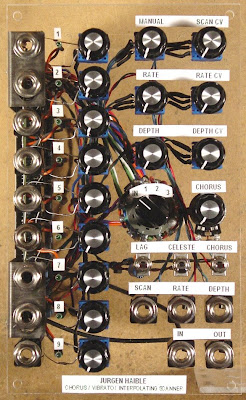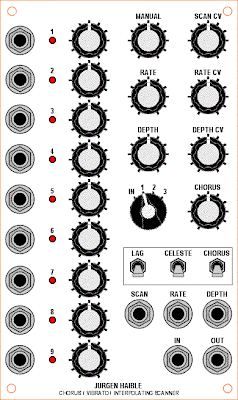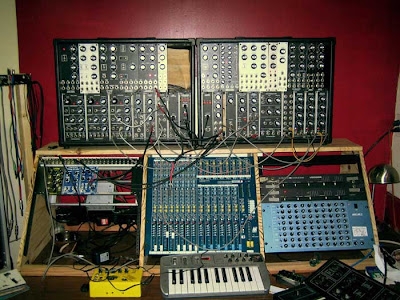18 Vishay/Spectrol Pots 24 Switchcraft 112APCX jacks"
via Krisp1 where it is listed for sale.
EVERYTHING SYNTH

 details on tellun.com
details on tellun.com
 via Scott of www.tellun.com on the ModularSynthPanels list:
via Scott of www.tellun.com on the ModularSynthPanels list:
 Top row:
Top row: P.S. In case anyone is wondering about the colored jacks, they are just the regular switchcraft type spraypainted
P.S. In case anyone is wondering about the colored jacks, they are just the regular switchcraft type spraypainted "The TLN-865 Trigger Extractor & Window Comparator is an adaptation of a window comparator from Jung's Op-Amp Cookbook. This circuit can also function as a trigger extractor. A window comparator produces an output that is high if the input signal is greater than the lower threshold and less than the upper threshold. Otherwise the output is low. In other words:" see the full discription for more.
"The TLN-865 Trigger Extractor & Window Comparator is an adaptation of a window comparator from Jung's Op-Amp Cookbook. This circuit can also function as a trigger extractor. A window comparator produces an output that is high if the input signal is greater than the lower threshold and less than the upper threshold. Otherwise the output is low. In other words:" see the full discription for more.
 images via this auction
images via this auction via Scott of tellun.com on the ModularSynthPanels list:
via Scott of tellun.com on the ModularSynthPanels list: "The TLN-863 Max Min Generator is a MUUB implementation of a Linear Or/And Gate from Jung's Op-Amp Cookbook. This circuit is very similar to Ken Stone's Analog Logic circuit and Dave Brown's Analogic circuit. With the MODE switch set to the MAX position, the output will be the maximum of inputs 1-3 (Linear Or). With the MODE switch set to the MIN position, the output will be the minimum of inputs 1-3 (Linear And). The THRESHOLD pot sets a voltage that is normalled to the input jacks when no signal is plugged into the jacks. This turns the circuit into a "Clipper" when the MODE switch is set to MIN (output voltage will not go below the THRESHOLD), and a "Clamper" when the MODE switch is set to MAX (output voltage will not exceed the THRESHOLD).
"The TLN-863 Max Min Generator is a MUUB implementation of a Linear Or/And Gate from Jung's Op-Amp Cookbook. This circuit is very similar to Ken Stone's Analog Logic circuit and Dave Brown's Analogic circuit. With the MODE switch set to the MAX position, the output will be the maximum of inputs 1-3 (Linear Or). With the MODE switch set to the MIN position, the output will be the minimum of inputs 1-3 (Linear And). The THRESHOLD pot sets a voltage that is normalled to the input jacks when no signal is plugged into the jacks. This turns the circuit into a "Clipper" when the MODE switch is set to MIN (output voltage will not go below the THRESHOLD), and a "Clamper" when the MODE switch is set to MAX (output voltage will not exceed the THRESHOLD). I posted about The Alison Project back on July 18 of 2006 and again on March 27 of 2007. Magnus wrote in to let me know the modular has grown to a gargantuan size as you can see in this image. Check out the gallery for more.
I posted about The Alison Project back on July 18 of 2006 and again on March 27 of 2007. Magnus wrote in to let me know the modular has grown to a gargantuan size as you can see in this image. Check out the gallery for more. "The TLN-156 Neural Agonizer is a voltage controlled spring reverb processor. Although this module can be used to simulate room reverb with most audio signals, it includes numerous enhancements specifically designed for interfacing to a modular synthesizer. If you're looking for a smooth, natural sounding reverb system to make your synthesizer sound like its being played in the Concertgebouw, then go buy a Lexicon. This is not your grandmother's reverb tank, this is a noxious tool capable of inflicting some serious damage to your audio.
"The TLN-156 Neural Agonizer is a voltage controlled spring reverb processor. Although this module can be used to simulate room reverb with most audio signals, it includes numerous enhancements specifically designed for interfacing to a modular synthesizer. If you're looking for a smooth, natural sounding reverb system to make your synthesizer sound like its being played in the Concertgebouw, then go buy a Lexicon. This is not your grandmother's reverb tank, this is a noxious tool capable of inflicting some serious damage to your audio. Click here for another workspace post on trash_audio.
Click here for another workspace post on trash_audio.











